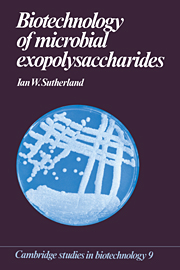Book contents
- Frontmatter
- Contents
- Preface
- 1 Introduction and definition
- 2 Polysaccharide analysis and structural determination
- 3 Exopolysaccharide structure
- 4 Enzymes degrading exopolysaccharides
- 5 Biosynthesis
- 6 Physiology and industrial production
- 7 Genetics, control and regulation of exopolysaccharide synthesis
- 8 Physical properties of exopolysaccharides
- 9 Food usage of exopolysaccharides
- 10 Industrial uses of microbial polysaccharides
- 11 Medical applications of exopolysaccharides
- 12 The future for microbial exopolysaccharides
- References
- Index
11 - Medical applications of exopolysaccharides
Published online by Cambridge University Press: 09 September 2009
- Frontmatter
- Contents
- Preface
- 1 Introduction and definition
- 2 Polysaccharide analysis and structural determination
- 3 Exopolysaccharide structure
- 4 Enzymes degrading exopolysaccharides
- 5 Biosynthesis
- 6 Physiology and industrial production
- 7 Genetics, control and regulation of exopolysaccharide synthesis
- 8 Physical properties of exopolysaccharides
- 9 Food usage of exopolysaccharides
- 10 Industrial uses of microbial polysaccharides
- 11 Medical applications of exopolysaccharides
- 12 The future for microbial exopolysaccharides
- References
- Index
Summary
Exopolysaccharides have a number of industrial applications which relate either directly or indirectly to medicine. One such is the use of dextran and its derivatives on both a laboratory and an industrial scale for the purification of compounds of medical interest, including Pharmaceuticals, and of enzymes for diagnostic purposes. Polysaccharides may also be used to encapsulate drugs for their gradual delivery and they may be used to immobilise enzymes employed for diagnosis or for the chemical modification of pharamaceutical products. These applications clearly utilise the functional properties of the polysaccharides, such as their rheology or capacity for gel formation. Alternatively, the pharmacological or other biological properties of the polymers may be employed. There are essentially three types of direct application of the biological properties of exopolysaccharides to medicine. The exopolysaccharides may be used as vaccines in preference to whole microbial cells or cultures. Thus side-effects due to other cell components such as lipopolysaccharides or proteins are avoided. On the other hand, not all polysaccharides are good immunogens, nor are the exopolysaccharides necessarily the major factors in the specific disease syndromes caused by the polysaccharide-producing microbial pathogens.
Several exopolysaccharides mimic eukaryotic polymers in their structural details. For this reason, they may be associated with certain specific diseases such as meningitis (in the case of sialic acid-synthesising bacteria). Some of these polysaccharides are, however, useful as substrates for determining enzyme specificity, and others are used as substitutes for the eukaryotic polymers. Finally, a number of exopolysaccharides having antitumour or antiviral activity have been identified.
- Type
- Chapter
- Information
- Biotechnology of Microbial Exopolysaccharides , pp. 141 - 148Publisher: Cambridge University PressPrint publication year: 1990
- 1
- Cited by



